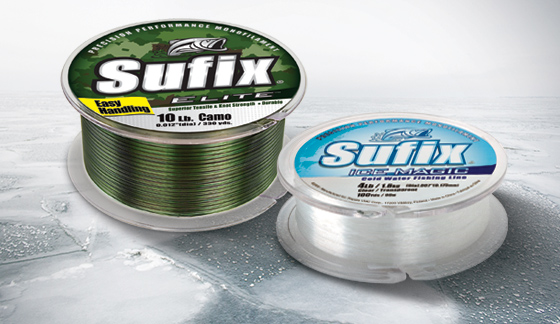
Don’t let old line snap your chance for a new record lunker this winter. Re-spool your reels before ice-up with fresh Sufix line and remove weakened line throughout the winter and re-tie.
“It’s just kind of a common-sense thing to change your line at the start of a new season,” explains ICE FORCE Pro-Staffer and Freshwater Fishing Hall of Fame “Legendary Guide” Tom Neustrom. “And because ice can be sharp and there’s a lot of things in a fish house and sled that can nick your line, it’s a good idea to strip off some line throughout the season to prevent break-offs. You don’t want to lose the fish-of-a-lifetime because you were trying to save a few cents-worth of line.”
Of course, if you’re fishing with old line, you might not hook that fish-of-a-lifetime in the first place. The longer fishing line resides on your reel’s spool, the more “memory” it will develop. Line with a lot of memory comes off your reel’s spool in tight coils, rather than straight. Those coils can prevent you from presenting your baits in the best way to get bites.
“When your line looks like a Slinky, it makes it tough to present your baits naturally, especially when you’re using lighter lures,” Neustrom explains.
To create the best fish-enticing action with a lure when ice fishing, you want your line completely vertical. Line coils will absorb the subtle motions you make with your rod tip, rather than transmitting that action to your bait.
Because of their smaller diameter, Neustrom says, the spools on ice-fishing reels have an even greater tendency to create line coils than their open-water counterparts.
Line Care Throughout The Season
Periodically removing some line throughout the ice-fishing season is also “critical to success,” Neustrom says.
“The edges of ice can be sharp, so it’s easy to get a nick in your line,” he explains. “But you won’t always know exactly where that nick is, because you might have reeled it up into the spool five or ten yards, so it’s a good thing to change your line often in the winter. I know I do.”
In a dozen to 15 fishing excursions, Neustrom will change his line as many as two or three times. “You don’t have to take all your line off,” he instructs. “You can take off 25 to 30 yards of it and re-tie and you’re good to go.”
Proper Spooling Technique
Improperly re-spooling new line can cause line twist, another obstacle to effective bait presentation. Neustrom’s re-spooling method is to lay his new spool of line label-side down on the floor, run the line through a big book to put little pressure on it, and then reel slowly, making sure the line is coming off the spool in a counter-clockwise direction.
“When you look at the direction of the rotation of the spool on your spinning reel, counteracting that will make sure you don’t have line twist,” he explains. “And I always put a little pressure on the line, especially for a spinning reel.”
Sufix By Species
On his walleye rods, Neustrom spools up 6- to 8-pound Sufix Elite monofilament line. “In the winter, I like a softer, more supple line,” he explains. For winter pike, he uses 8- to 10-pound Sufix Elite.
Featuring unbeatable strength, easy handling, and superior tensile and knot strength, Sufix Elite line comes in 10 test-strengths and four colors (camo, clear, hi-vis yellow and low-vis green).
Neustrom strings his panfish rods with 2- to 4-pound test Sufix Ice Magic. With a lighter line, he explains, “you can use much lighter baits and they’ll be effective.”
A high performance monofilament designed to stay manageable even in frigid water, Sufix Ice Magic features special additives that deter water absorption that causes ice build-up. Additionally, it sinks fast for a more natural presentation.
“It’s really soft and supple and performs really well for me,” Neustrom says. “And it’s very consistent and has very good knot strengths.”
Sufix Ice Magic line comes in six test-strengths (1, 2, 3, 4, 6 and 8) and two colors (clear, neon orange).